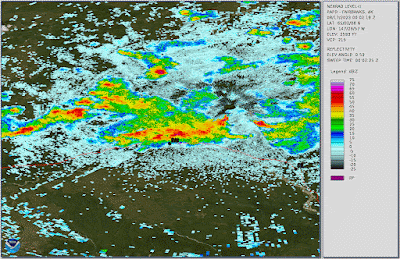Continued dry and very warm weather has allowed fire activity to persist in the central interior, and unfortunately for Fairbanks the air quality has gone badly downhill, with visibility dropping to just a mile and a quarter in smoky conditions yesterday. This isn't as bad as
last year, but it's certainly unpleasant.
Statewide total fire acreage has risen above 110,000 acres as of yesterday, with 35,000 acres tallied on Sunday alone. It's been 4 years since this much acreage burned this late in the season, but of course there have been much worse fire seasons in the past.
Before going any further, I must make a quick note also of the record heat at Utqiaġvik, where Saturday was easily the warmest day on record. The daily mean temperature of 66°F smashed the record of 63.5°F that was
tied just a couple of weeks ago; and the daily low temperature of 56°F was also easily an all-time record (formerly 53°F). Breaking all-time temperature records by this margin - with a period of record of more than a century - is no small feat, and it will cement this late summer heat wave as an historic event.
In my
last post, I mentioned the seasonality of relative humidity as a major factor for the typical late summer drop-off in Alaska's fire activity. Thinking a bit more about this, I decided to revisit
an analysis from 2014 in which I looked at trends in "vapor pressure deficit" or VPD in Fairbanks. From a fundamental standpoint, VPD is more directly correlated with evaporation and fire fuel drying than relative humidity; for example, low relative humidity at low temperatures does not produce much evaporation at all.
After updating my 2014 charts, here's a look at June-August average daily temperature, dewpoint, and (in columns) VPD. Interestingly, there's only a very slight upward trend in VPD overall, although both temperature and dewpoint have trended up modestly. As it turned out, the extreme summer of 2013 (record high VPD) did not portend a change to drier conditions, but in fact summers have generally been humid and wet in Fairbanks since then.
There's much more of an upward VPD trend for the month of May, however, and this is consistent with Alaska's rapid long-term warming in spring, and the known trend towards a longer fire season. Last year (2022) was an example of remarkably
early and aggressive fire activity.
The charts for June, July, and August illustrate the rapid seasonal drop-off in evaporative potential - see below - and of course with sunshine weakening, days shortening, and rainfall increasing in late summer as well, the odds are stacked against fire activity by the time the calendar reads August.
The chart below shows an alternative historical perspective based on the number of days that would be considered very favorable for fire activity, i.e. days with a peak VPD value above 2.5kPa in Fairbanks. A VPD of 2.5kPa can occur with hot and humid conditions such as a temperature of 86°F and dewpoint of 58°F (relative humidity about 40%), or it can occur on a cooler but very dry day such as a temperature of 74°F and a dewpoint of 20°F (RH about 15%). Either way, a lot of evaporation is occurring.

2013 was a remarkable outlier for high-evaporation days in Fairbanks, but it wasn't an extremely active fire year, simply because of the lack of lightning: it was too dry for widespread ignitions. The historical relationship between high VPD days and seasonal fire acreage (see below) shows that nearly all years with more than 10 very dry days do produce at least a million-acre fire season, and conversely it's rare to get a big season without at least a handful of dry days. For reference, 2023 is up to 8 such dry days in Fairbanks, with Sunday being the most recent.
Average VPD for June-August gives a broadly similar relationship to the high-VPD days - see below - although there are a number of very inactive fire years with above-normal VPD for the summer as a whole. Presumably it's the really dry days that matter more, as those produce rapid fire spread and account for a disproportionate fraction of the seasonal activity.
And finally, a bit of good news, and not at all surprising for the time of year: some rain is on the way this week, and temperatures are predicted to drop off quite substantially in the next two weeks. Fire activity should wind down accordingly. Here's the latest 6-10 day forecast from CPC:



















































